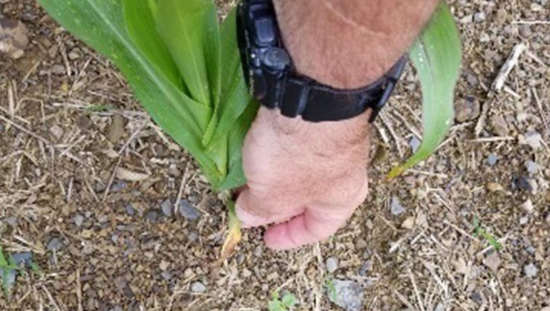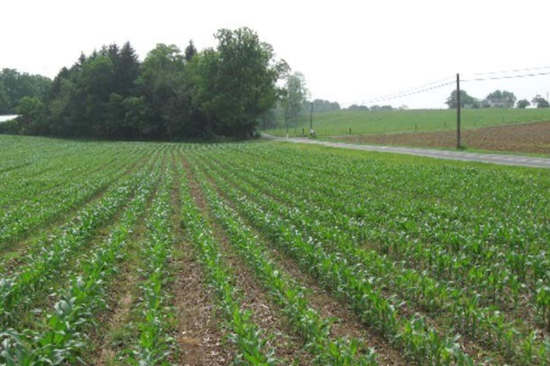By DELBERT G. VOIGHT
Key Points:
- Historic rainfall over the past year has impacted the nitrate form of N applied (really all mobile nutrients) and in many cases may have been moved out of the soil system. To further complicate the issue, sulfur has also shown up to be a potential barrier in area crop fields.
- Calculating additional nitrogen (N) is important to ensure adequate N for this season’s crop. All time that the crop stays deficient in N, or appears yellow, reduces yields and is important to correct immediately.
- Diagnostic tools like chlorophyll meters and side dress soil testing are available to determine what soil N is available and what additional N is needed.
- Supplemental N will help maintain corn yield after heavy rain events.
- Rescue treatments should be made as soon as possible and are most likely to return income if applied prior to tasseling.
- Application techniques - considerations from broadcast of urea or side dressing with UAN.
Introduction:
Over the past year, historic rainfall has occurred in many areas of the state. In saturated soils denitrification is the major cause of nitrogen loss. There are numerous fields with yellowing symptoms, most showing characteristic N deficiency. Soil drainage will affect this; obviously the higher up slope areas will affect the number of days the soil is at a saturation point. In reading an article from Iowa State, soil nitrate is converted to a gas by soil bacteria (denitrification) in as little as two days of waterlogged soils. Researchers (several universities) estimate about 4% loss of nitrate for each day of saturation.

Wet soils cause nitrogen losses. In cases where high intensity rain results in high runoff, leaching losses will probably be low. The primary nitrogen loss mechanism in saturated soils is denitrification, which occurs when soil nitrate nitrogen (NO3-N) is converted to nitrogen gas by soil bacteria. Two to three days of soil saturation is required for bacteria to begin the denitrification process.
Well-drained upland soils that have been wet from a series of rains probably have not experienced much denitrification. Soils in lower landscape positions that stay saturated longer will likely lose more N. This season I had some fields with compaction that limited root growth into N rich soils. In an extreme case, illustrated in the picture, the pipeline severely impacted the roots due to compaction and nutrient uptake. While the whole field was treated the same, with regarding N, the impacted area could not reach the N applied at the time. We utilized a small application of N for plant growth without having to apply the total N demand, based on the grower’s initial application.
Losses can be calculated by estimating 3 to 4 percent loss of fertilizer NO3-N for each day of saturation. Use the Table below to determine how much fertilizer NO3-N was in the soil. Dr Chad Lee reported the following table in his Kentucky Extension Blog. It illustrates the nitrate conversion over time based on the material selected by growers the result of loss will be different.
The corn on the left (dark green) is healthy unaffected growth corn, while the corn on the right (yellow) is affected by compaction and unable to intercept the nutrients it needs. D. Voight.
Table 1. The amount of applied fertilizer that is in the nitrate nitrogen form 0, 3, and 6 weeks after application.
| Nitrogen Source | 0 Week:
% Fertilizer as NO3*N | 3 weeks:
% Fertilizer as NO3*N | 6 weeks:
% Fertilizer as NO3*N |
|---|
| Anhydrous Ammonia (AA) | 0 | 20 | 65 |
| AA with N-Serve* | 0 | 10 | 50 |
| Urea | 0 | 50 | 75 |
| Urea with N-Serve* | 0 | 30 | 70 |
| UAN | 25 | 60 | 80 |
| Ammonium Nitrate | 50 | 80 | 90 |
*Nitrification inhibitor that slows transformation of ammonium to nitrate.
EXAMPLE: Determining the Amount of N Loss
I am using Dr. Lee’s lead to use an example for our PA soil conditions.
A farmer applied 150 lb nitrogen (N)/A as UAN to corn grown on poorly drained soil. Immediately after application the field became saturated for 10 days. How much N was lost?
Step 1. Determine the amount of applied N that was in the nitrate (NO3‐N) form.
According to the table, 80% of the UAN will be in the NO3‐N form after three weeks of the application. 150 lb N x 80% = 120 lb N.
Step 2. Determine the amount of N lost.
Remember that two days are needed for the bacteria to begin the denitrification process. Therefore, denitrification occurred for eight days (ten days total saturation minus two days to start the process). With 4% lost each day for eight days, 32% would have been lost. 120 lb N x 32% = 38.4 lb N lost and 111.6 lb N remaining. Take note that in most cases, the N loss is not as high as the grower might assume given the rainfall.
Diagnostic Tools to assess N requirements.
If a commercial source of N is used as the sole source the grower then needs to calculate the losses as above example or use the PSNT to determine additional N requirements. Most growers using Manure N source should consider some of the following options.
- Nitrogen Soil Test - An additional tool for determining NO3‐N in the soil after flooding is a NO3‐N test. The Penn State Ag Analytical Lab will test this and give recommendations for management based on the nitrate test results.
- Chlorophyll meter - The SPAD meter and/or Chlorophyll meter has been extremely useful in this season. I have three units in my office for use and they are used daily this time of year. Very simple to use and results are immediate. In fact, we use them right ahead of the side dress rig to determine N applications in real time. The key is that it is used is only where less than 15lb of commercial N is used up front. This technique is useful for growers using manure source N to determine the need for additional N. The field below appears green, however the SPAD meter reading of 42 indicated it needs an additional application to maximize yield.
- Late Season Corn Stalk Nitrate Test - Do not overlook the utility of the late season stalk N option. This test is designed to determine if N was limiting in that season. It is highly useful in fine tuning N tactics. The procedure is simple to follow, and this season may prove to be highly useful in assessing tactics used mid-season this year.
- Tissue Testing - Once the plant gets into the later stages it might be a useful tool to tissue test. It is not as valuable in the vegetative stages so hold off until the plant has silks and tassels on it. It is important to collect the leaves at the proper stage of growth so the lab test may be compared to historic data for management.
- Nitrogen Modeling - Dr. Charlie White wrote in a recent article in FCN that computer modeling is also an option. “To my knowledge, the only tools available to assess the losses of early applied N fertilizers, and whether there is a need to compensate for these losses with an additional side dress N application, are computer models of the N cycle that take into account real-time, high resolution rainfall and temperature data for a location. Models such as Adapt-N and Encirca are now widely available and being increasingly used for N management decision making. These computer models are a compilation of the best available science of how the N cycle operates and the expert judgement of model developers on how to represent these N cycling processes as algorithms in the computer code. Ultimately, the success of these models also depends on having accurate inputs, including soil profile characteristics and previous N management practices, and being able to interpret the outputs correctly. Because of this, N modeling services in some cases may only be available through trained professionals that can help assure the integrity of the inputs and interpretation of the outputs.”

Application Options
There are only two ways to side dress with minimal effect on the standing crop. Broadcast urea and/or side dress Urea and/or UAN. I am aware of some specialized spreaders that track with the rows of corn and some tractor mounted spinners as well that will aid in the clearance over taller corn. Expect some burn from urea over the top but in most cases it is minimal. However, UAN over the top will result in significant burning and thus requires side dressing.
What about N stabilizers? This can be an option for urea treated with a urease inhibitor but in general with the need for rapid conversion it is wise to avoid any the other materials that may lessen the available N.
How late can I apply N? Dr. Sawyer from Iowa State Extension had written this in a bulletin regarding timing. “It is best to get the N on as early as possible. However, yield responses that return income greater than the costs for application and fertilizer materials have been observed for N applied up to and slightly beyond the tassel stage. The magnitude of yield increase is dependent upon the severity of N deficiency and the ability of the crop to recover and respond to applied N (the growth and yield potential left after water damage and early season N deficiency). Any surface application is dependent upon rainfall to move applied N into the root zone, otherwise it cannot benefit the corn crop”
Nitrogen Broadcast Prior to Rain - Dr. Lee had this to report regarding N applications prior to heavy rain. “Farmers sometimes broadcast fertilizer nitrogen on a field within 24 hours of a heavy rain. In most cases, very little nitrogen is lost to runoff, especially if the field was under no‐till soil management. The nitrogen fertilizer begins to dissolve almost immediately after being applied to the soil surface and will dissolve completely in a short period of time. As rain begins, the first water that falls moves into the soil, taking most of the fertilizer nitrogen with it. Once in the soil, most of the fertilizer nitrogen is protected from runoff. The only exception is a very intense rain soon after application that also erodes topsoil from sloping areas. Even in this situation, the loss would probably be less than one third of the fertilizer applied.”
Summary
- At this time, it is important to assess N demand and need for additional nutrients that may have leached from the soil profile.
- There are many tools available to assess the need and determine an economic application for N
- It is best to side dress N and/or if broadcast utilize urea to minimize damage to the crop. Consider only urease inhibitors if at all for stabilizers on N. Grower should check on the price per unit of N and application costs to ensure they maximize savings while meeting the need of the crop.
- Explore the use of other tools in an overall N and micronutrient assessment with tissue testing as tassels and silks emerge.
- Finally, this really points to the need to consider planned side dress applications in the future rather than relying on all the N up front leaving it susceptible to these kinds of weather events.